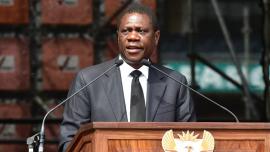
Deputy President Paul Mashatile emphasised the need to strengthen multi-sectoral partnerships to increase opportunities for youth empowerment and participation in the labour market.
“Together, we can contribute to national efforts to create employment and get South Africans working,” he said on Tuesday.
Deputy President Mashatile was speaking at the National Council of Provinces during a question and answer session.
In 2020, he said Cabinet approved the National Youth Policy (NYP) 2030, which is a cross-sectoral policy intended to redress the injustices of the past and deal decisively with new challenges affecting the youth.
To reduce youth unemployment, the Deputy President said the Minister of Finance set aside R7.4 billion for the Presidential Employment Initiative for the 2024/25 financial year.
“Thus far, the Presidential Employment Initiative has assisted over 1.7 million people through a combination of job creation, job retention and income and skills support interventions," Mashatile said.
He also touched on the South African Employment Services System, which serves over seven million job seekers, and provides nationwide platforms for youth to register for employment, match with employment opportunities, and receive placement counselling.
Through public-private partnerships, government supports various internships, learnerships, and apprenticeship programmes across various government departments to provide experiential learning and facilitate entry into the labour market for young people.
By supporting the growth of Small, Medium and Micro Enterprises (SMMEs), he stated that government is playing a critical role in addressing South Africa’s youth unemployment crisis.
“Government is also implementing the Preferential Procurement Policy Framework Act to promote SMMEs that are key to job creation, and economic growth,” he added.
Agricultural land
Shifting his focus to agricultural land, he said government is accelerating land redistribution through a variety of instruments, such as land restitution and expropriation of land, to boost agricultural output.
In 2023, the Minister of Public Works and Infrastructure announced that 221 land parcels measuring 148 796 hectares have been released to the Department of Agriculture, Land Reform, and Rural Development for transfer to the approved land claimants.
“Approximately 1 576 hectares of land is earmarked to be released before the end of this financial year,” he announced.
In addition, he said 125 land parcels, measuring 25 549 hectares of agricultural land were released to support subsistence farming and food security.
“This is in keeping with what we have been doing over the last 30 years,” he explained.
Meanwhile, the government is transferring State agricultural land, through Financial Assistance Land (FALA) properties, where there has been compliance with the rent-to-buy agreements.
On top of that, the Department of Agriculture, Land Reform and Rural Development, he said, is developing criteria for category 3 and commercial farmers as part of the rollout plan for the release of state land.
“Category 3 includes medium to large-scale commercial farmers who have already been, or intend to farm commercially at various scales, but are disadvantaged by location, size of land, and other resource constraints limiting their growth,” the Deputy President explained.
As per the country’s second-in-command, the Department of Public Works and Infrastructure holds national State-owned land. It receives requests from the Department of Agriculture, Land Reform and Rural Development for releasing land to settle claims for restitution and agricultural purposes as part of the land reform programme.
“As a government, we will prioritise providing extension and technical support to ensure that we distribute properties that are productive and contribute to South Africa’s food security,” Mashatile said. – SAnews.gov.za


